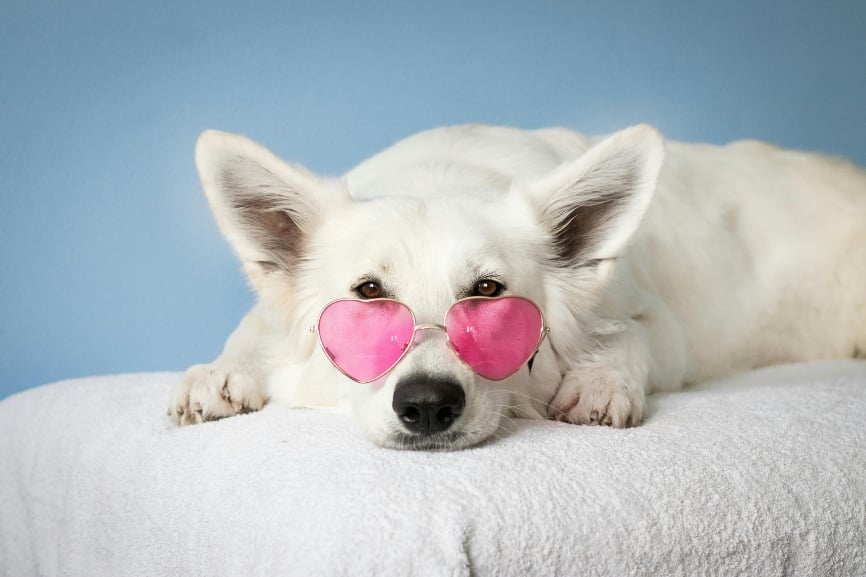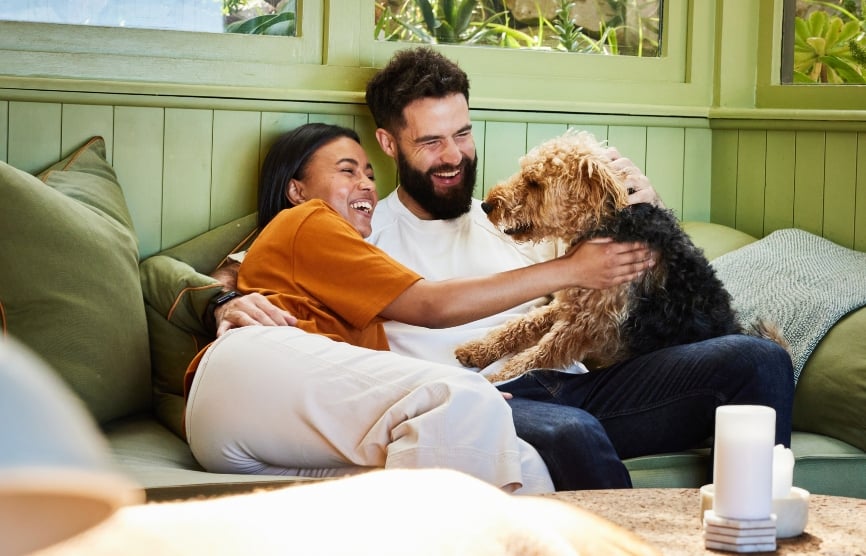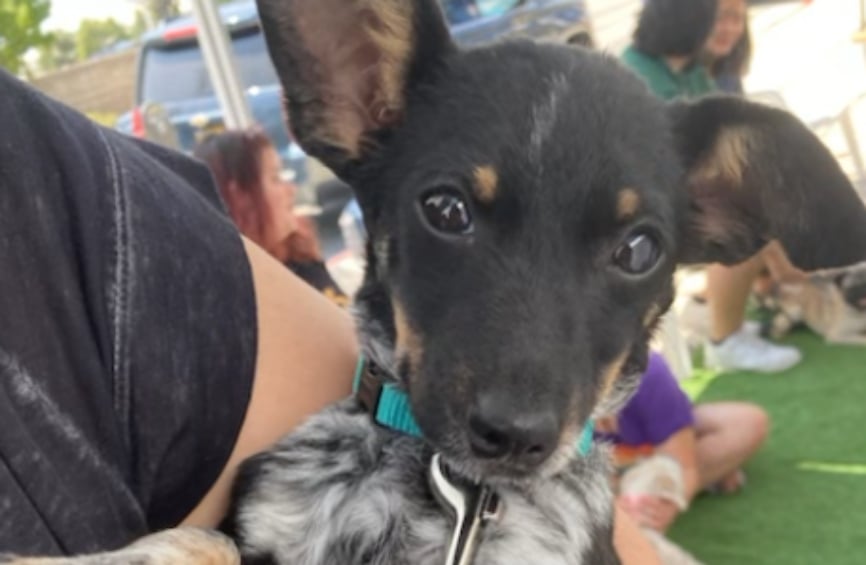Table of Contents
Training isn’t just for puppies! Whether newly adopted or a long-time family member, all dogs young and old (and their humans!) can benefit from training. Basic training commands can help keep your dog safe in certain situations and can also help to tackle problem behaviors.
What you’ll need:
- A distraction-free zone: for each of these commands, we recommend training in a quiet room of the house to start
- Lots of tiny treats (or larger ones broken up into small, pea-sized pieces)
- A relaxed dog: energetic dogs will quickly lose patience or get distracted, so try to tire your dog with a walk or play session first
- Plenty of patience
Though your cue word of choice may vary, for example, “wait” instead of “stay”, these six behaviors are what we’re working on. In addition to verbal cues, consider associating a hand gesture with each command as a secondary way of communicating with your dog.
Train your dog to sit
Being one of the easiest commands to teach, this is a great place to start.
- Hold a treat in front of your dog’s nose.
- Say “sit” and raise the treat up and slightly over your dog’s head. They’ll be inclined to follow it with their nose, resulting in either a sit or a few steps backward.
- If repeated attempts result in backward steps, gently press down on your pup’s behind to guide him into a sit.
- When their bottom hits the floor, immediately offer the treat and verbal praise.
Practice having your dog sit before opening the door to go outside, and before placing their food bowl down.
How to train “down”
Since this position is a submissive posture, it may be more difficult to train, especially with fearful or anxious dogs. Be patient and positive with plenty of treats on hand.
- Starting in a sit position, hold a treat in front of your dog’s nose and say “down” while drawing the treat down toward the floor for your dog’s nose to follow.
- Move the treat away from your dog along the floor to encourage his body to follow his head.
- It may take several attempts, but once your dog is in the desired position, offer immediate praise and treats.
Teach your dog to come
A solid recall is invaluable in dangerous situations, like if your dog were to escape from your home or the dog park, or if you lose control of the leash. The important part about teaching recall is to make the experience highly positive every time with plenty of praise and extra tasty treats. If your dog learns that he gets in trouble or that playtime is over when he returns to you, he’ll be less inclined to come back next time.
Tip: Be sure you have your dog’s attention before calling “come” and only call him when he’s more likely to return. If he isn’t paying attention and you have to call multiple times, this will teach your dog that he doesn’t always have to react to your cue word.
- In an enclosed space, start by distancing yourself from your dog and say “come”. You can show him the treat to entice him to come. When he arrives, offer treats and praise.
- Another approach is to trot away from your dog while saying “come”. His instincts to play and chase will encourage him to come after you.
- Once your dog has a solid recall in a distraction-free area, try practicing in a low-distraction location such as an empty park and attach your dog to a 15- or 20-foot leash (don’t use a retractable leash). The next step would be to practice off-leash in an enclosed/fenced area.
The dog park is another great place to practice ‘come’ because you can repeat it multiple times during your park visit. Plus, your dog gets the positive experience of being released after returning to you, so the command isn’t always associated with a punishment (getting leashed and taken out of the park).
How to train “stay”
A dog that has mastered ‘stay’ will remain in the same place until they hear the release word, such as “OK”.
- Start with your dog in a resting position, such as sitting or lying down. Say “stay” and take a few steps backward. After a few seconds, say “OK” and return to your dog with a reward.
- Gradually increase the duration of time before you return to your dog.
- Gradually increase the distance you move away from your dog.
- Gradually increase the level of distraction your dog has to endure, such as a family member dangling a toy off to the side, all the way up to practicing at the dog park.
If your dog doesn’t successfully stay, go back a step or two by reducing the duration or distance. ‘Stay’ will take plenty of practice over a span of time, especially with younger puppies or high-energy dogs.
Train your dog to “leave it”
Equip yourself with a “boring” treat like a dry biscuit and a handful of very enticing, yummy treats.
- Sitting on the floor in front of your dog, hold a yummy treat in one hand and place the boring treat on the floor, loosely cupping your other hand over it to protect it from your dog.
- As your dog sniffs at your cupped hand, say “leave it” only once, and wait for your dog to pull his nose away from your hand. If he is adamant, close your hand on the treat or hide it in your fist.
- When he backs off or looks away, even slightly, offer praise and a reward with a yummy treat.
- Gradually increase the challenge after a few successful rounds by loosening your hand around the boring treat, then hovering it over the treat, and finally, removing your hand completely.
- The next levels of difficulty include standing up (and using your foot to cover the treat if your dog goes for it), moving further away from your dog and the treat, or using more enticing treats or toys that your dog has to practice leaving alone.
This command is particularly useful for curious puppies that are exploring the world with their mouths, or if your dog comes across an enticing smell that might be dangerous, like discarded chicken bones. ‘Leave it’ is meant to teach your dog that he receives a great reward for ignoring the other item.
How to train “drop it”
For this one, you’ll need a toy or ball that your dog enjoys. You can also practice training ‘drop it’ any time your dog is already playing with a toy.
- Tempt your dog to grab hold of a toy if he is not already doing so.
- When your dog’s mouth is on the toy, bring a treat close to his nose and say, “drop it”.
- When he releases the toy, immediately give him the treat and verbal praise.
- Increase difficulty by using objects that are more tempting than a toy, like a hard, edible chew.
Training can be fun, especially when things start to click! To solidify any training command, we recommend practicing several successful repetitions of each command over several days and in various settings/locations. Regular practice throughout your dog’s life will help keep the command fresh so your dog will behave instantly upon hearing the command. Now what are you waiting for? Let’s start training!







